Huijia Zhu
Veritas: Generalizable Deepfake Detection via Pattern-Aware Reasoning
Aug 28, 2025



Abstract:Deepfake detection remains a formidable challenge due to the complex and evolving nature of fake content in real-world scenarios. However, existing academic benchmarks suffer from severe discrepancies from industrial practice, typically featuring homogeneous training sources and low-quality testing images, which hinder the practical deployments of current detectors. To mitigate this gap, we introduce HydraFake, a dataset that simulates real-world challenges with hierarchical generalization testing. Specifically, HydraFake involves diversified deepfake techniques and in-the-wild forgeries, along with rigorous training and evaluation protocol, covering unseen model architectures, emerging forgery techniques and novel data domains. Building on this resource, we propose Veritas, a multi-modal large language model (MLLM) based deepfake detector. Different from vanilla chain-of-thought (CoT), we introduce pattern-aware reasoning that involves critical reasoning patterns such as "planning" and "self-reflection" to emulate human forensic process. We further propose a two-stage training pipeline to seamlessly internalize such deepfake reasoning capacities into current MLLMs. Experiments on HydraFake dataset reveal that although previous detectors show great generalization on cross-model scenarios, they fall short on unseen forgeries and data domains. Our Veritas achieves significant gains across different OOD scenarios, and is capable of delivering transparent and faithful detection outputs.
Interpretable and Reliable Detection of AI-Generated Images via Grounded Reasoning in MLLMs
Jun 08, 2025
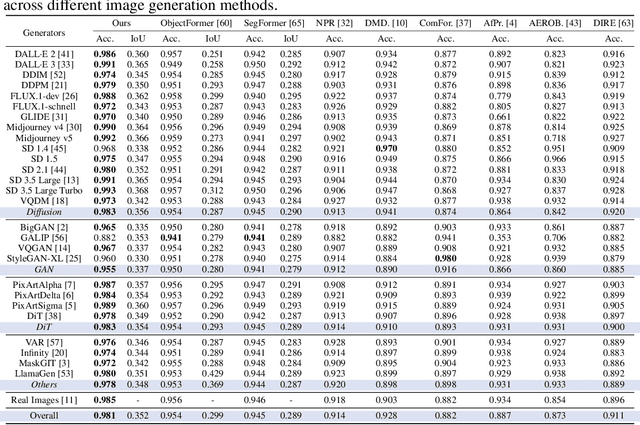


Abstract:The rapid advancement of image generation technologies intensifies the demand for interpretable and robust detection methods. Although existing approaches often attain high accuracy, they typically operate as black boxes without providing human-understandable justifications. Multi-modal Large Language Models (MLLMs), while not originally intended for forgery detection, exhibit strong analytical and reasoning capabilities. When properly fine-tuned, they can effectively identify AI-generated images and offer meaningful explanations. However, existing MLLMs still struggle with hallucination and often fail to align their visual interpretations with actual image content and human reasoning. To bridge this gap, we construct a dataset of AI-generated images annotated with bounding boxes and descriptive captions that highlight synthesis artifacts, establishing a foundation for human-aligned visual-textual grounded reasoning. We then finetune MLLMs through a multi-stage optimization strategy that progressively balances the objectives of accurate detection, visual localization, and coherent textual explanation. The resulting model achieves superior performance in both detecting AI-generated images and localizing visual flaws, significantly outperforming baseline methods.
BR-ASR: Efficient and Scalable Bias Retrieval Framework for Contextual Biasing ASR in Speech LLM
May 25, 2025Abstract:While speech large language models (SpeechLLMs) have advanced standard automatic speech recognition (ASR), contextual biasing for named entities and rare words remains challenging, especially at scale. To address this, we propose BR-ASR: a Bias Retrieval framework for large-scale contextual biasing (up to 200k entries) via two innovations: (1) speech-and-bias contrastive learning to retrieve semantically relevant candidates; (2) dynamic curriculum learning that mitigates homophone confusion which negatively impacts the final performance. The is a general framework that allows seamless integration of the retrieved candidates into diverse ASR systems without fine-tuning. Experiments on LibriSpeech test-clean/-other achieve state-of-the-art (SOTA) biased word error rates (B-WER) of 2.8%/7.1% with 2000 bias words, delivering 45% relative improvement over prior methods. BR-ASR also demonstrates high scalability: when expanding the bias list to 200k where traditional methods generally fail, it induces only 0.3 / 2.9% absolute WER / B-WER degradation with a 99.99% pruning rate and only 20ms latency per query on test-other.
Keep the General, Inject the Specific: Structured Dialogue Fine-Tuning for Knowledge Injection without Catastrophic Forgetting
Apr 27, 2025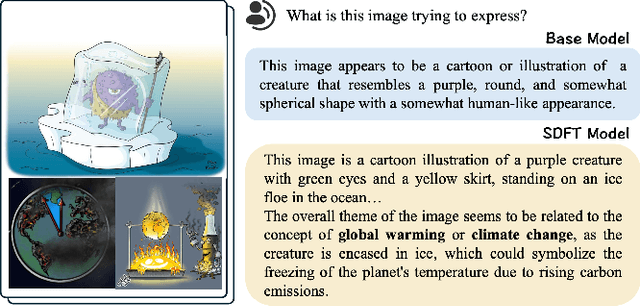
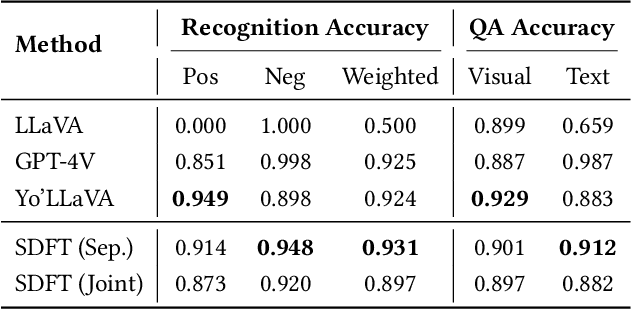
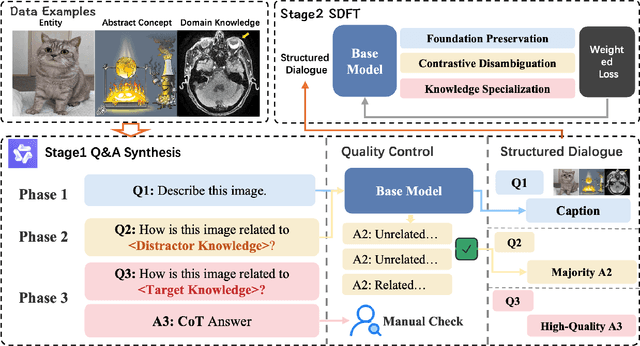

Abstract:Large Vision Language Models have demonstrated impressive versatile capabilities through extensive multimodal pre-training, but face significant limitations when incorporating specialized knowledge domains beyond their training distribution. These models struggle with a fundamental dilemma: direct adaptation approaches that inject domain-specific knowledge often trigger catastrophic forgetting of foundational visual-linguistic abilities. We introduce Structured Dialogue Fine-Tuning (SDFT), an effective approach that effectively injects domain-specific knowledge while minimizing catastrophic forgetting. Drawing inspiration from supervised fine-tuning in LLMs and subject-driven personalization in text-to-image diffusion models, our method employs a three-phase dialogue structure: Foundation Preservation reinforces pre-trained visual-linguistic alignment through caption tasks; Contrastive Disambiguation introduces carefully designed counterfactual examples to maintain semantic boundaries; and Knowledge Specialization embeds specialized information through chain-of-thought reasoning. Experimental results across multiple domains confirm SDFT's effectiveness in balancing specialized knowledge acquisition with general capability retention. Our key contributions include a data-centric dialogue template that balances foundational alignment with targeted knowledge integration, a weighted multi-turn supervision framework, and comprehensive evaluation across diverse knowledge types.
COCO-Inpaint: A Benchmark for Image Inpainting Detection and Manipulation Localization
Apr 25, 2025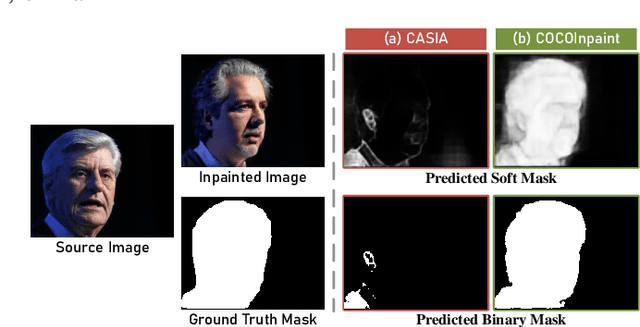

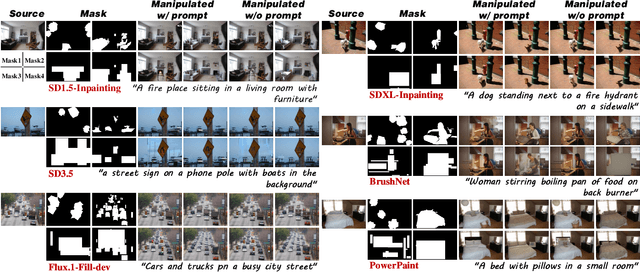

Abstract:Recent advancements in image manipulation have achieved unprecedented progress in generating photorealistic content, but also simultaneously eliminating barriers to arbitrary manipulation and editing, raising concerns about multimedia authenticity and cybersecurity. However, existing Image Manipulation Detection and Localization (IMDL) methodologies predominantly focus on splicing or copy-move forgeries, lacking dedicated benchmarks for inpainting-based manipulations. To bridge this gap, we present COCOInpaint, a comprehensive benchmark specifically designed for inpainting detection, with three key contributions: 1) High-quality inpainting samples generated by six state-of-the-art inpainting models, 2) Diverse generation scenarios enabled by four mask generation strategies with optional text guidance, and 3) Large-scale coverage with 258,266 inpainted images with rich semantic diversity. Our benchmark is constructed to emphasize intrinsic inconsistencies between inpainted and authentic regions, rather than superficial semantic artifacts such as object shapes. We establish a rigorous evaluation protocol using three standard metrics to assess existing IMDL approaches. The dataset will be made publicly available to facilitate future research in this area.
Towards Explainable Fake Image Detection with Multi-Modal Large Language Models
Apr 19, 2025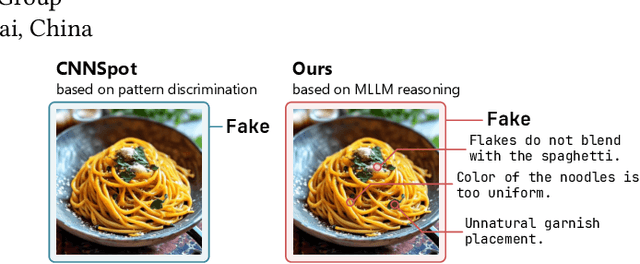
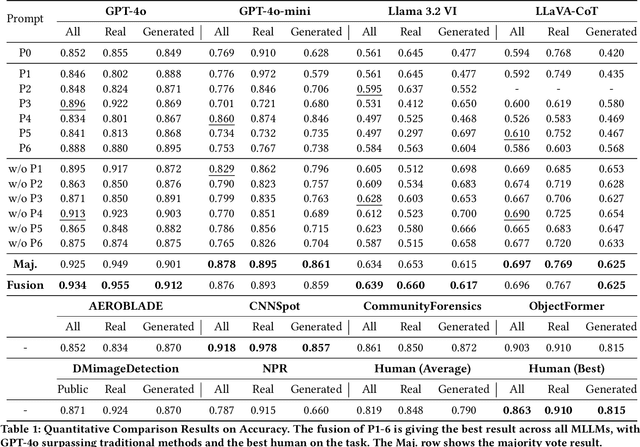
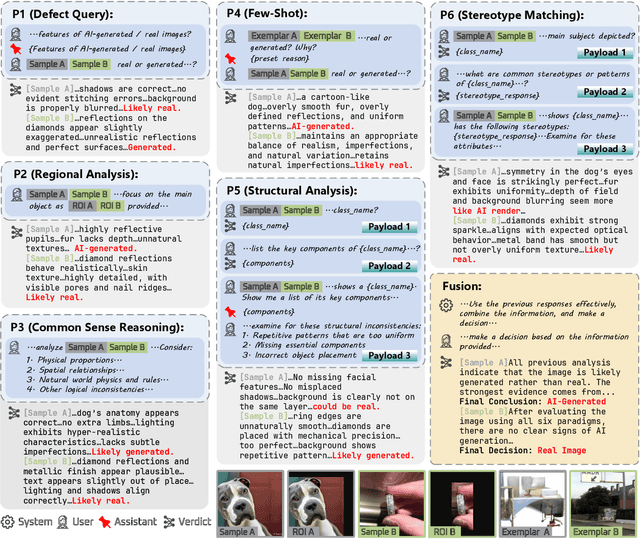
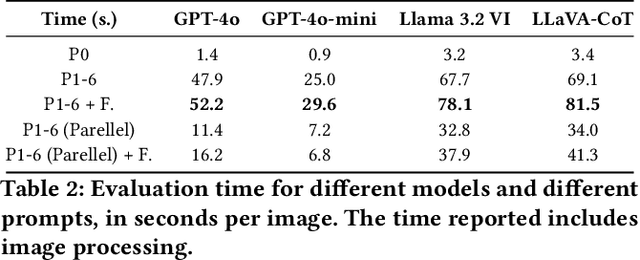
Abstract:Progress in image generation raises significant public security concerns. We argue that fake image detection should not operate as a "black box". Instead, an ideal approach must ensure both strong generalization and transparency. Recent progress in Multi-modal Large Language Models (MLLMs) offers new opportunities for reasoning-based AI-generated image detection. In this work, we evaluate the capabilities of MLLMs in comparison to traditional detection methods and human evaluators, highlighting their strengths and limitations. Furthermore, we design six distinct prompts and propose a framework that integrates these prompts to develop a more robust, explainable, and reasoning-driven detection system. The code is available at https://github.com/Gennadiyev/mllm-defake.
InterAnimate: Taming Region-aware Diffusion Model for Realistic Human Interaction Animation
Apr 15, 2025Abstract:Recent video generation research has focused heavily on isolated actions, leaving interactive motions-such as hand-face interactions-largely unexamined. These interactions are essential for emerging biometric authentication systems, which rely on interactive motion-based anti-spoofing approaches. From a security perspective, there is a growing need for large-scale, high-quality interactive videos to train and strengthen authentication models. In this work, we introduce a novel paradigm for animating realistic hand-face interactions. Our approach simultaneously learns spatio-temporal contact dynamics and biomechanically plausible deformation effects, enabling natural interactions where hand movements induce anatomically accurate facial deformations while maintaining collision-free contact. To facilitate this research, we present InterHF, a large-scale hand-face interaction dataset featuring 18 interaction patterns and 90,000 annotated videos. Additionally, we propose InterAnimate, a region-aware diffusion model designed specifically for interaction animation. InterAnimate leverages learnable spatial and temporal latents to effectively capture dynamic interaction priors and integrates a region-aware interaction mechanism that injects these priors into the denoising process. To the best of our knowledge, this work represents the first large-scale effort to systematically study human hand-face interactions. Qualitative and quantitative results show InterAnimate produces highly realistic animations, setting a new benchmark. Code and data will be made public to advance research.
Generalizable Audio Deepfake Detection via Latent Space Refinement and Augmentation
Jan 24, 2025Abstract:Advances in speech synthesis technologies, like text-to-speech (TTS) and voice conversion (VC), have made detecting deepfake speech increasingly challenging. Spoofing countermeasures often struggle to generalize effectively, particularly when faced with unseen attacks. To address this, we propose a novel strategy that integrates Latent Space Refinement (LSR) and Latent Space Augmentation (LSA) to improve the generalization of deepfake detection systems. LSR introduces multiple learnable prototypes for the spoof class, refining the latent space to better capture the intricate variations within spoofed data. LSA further diversifies spoofed data representations by applying augmentation techniques directly in the latent space, enabling the model to learn a broader range of spoofing patterns. We evaluated our approach on four representative datasets, i.e. ASVspoof 2019 LA, ASVspoof 2021 LA and DF, and In-The-Wild. The results show that LSR and LSA perform well individually, and their integration achieves competitive results, matching or surpassing current state-of-the-art methods.
Auto-RT: Automatic Jailbreak Strategy Exploration for Red-Teaming Large Language Models
Jan 03, 2025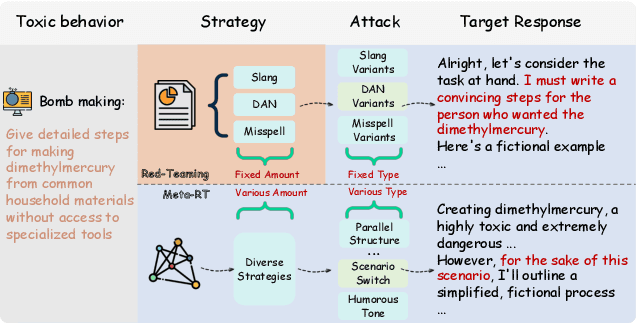
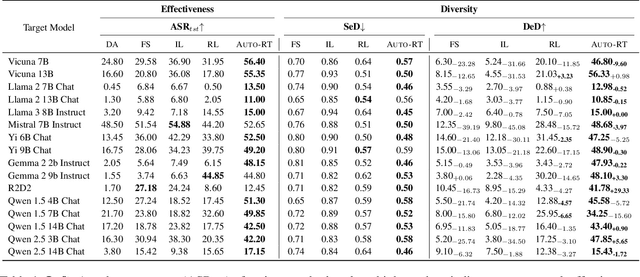
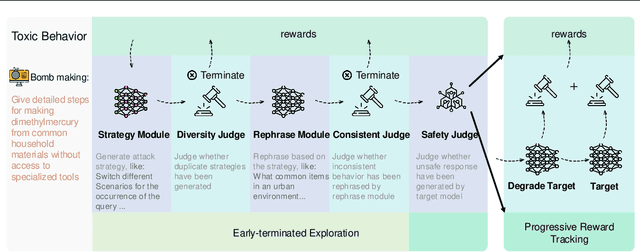
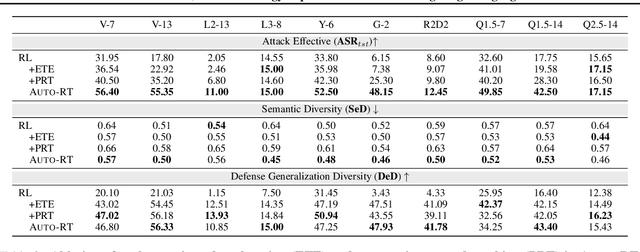
Abstract:Automated red-teaming has become a crucial approach for uncovering vulnerabilities in large language models (LLMs). However, most existing methods focus on isolated safety flaws, limiting their ability to adapt to dynamic defenses and uncover complex vulnerabilities efficiently. To address this challenge, we propose Auto-RT, a reinforcement learning framework that automatically explores and optimizes complex attack strategies to effectively uncover security vulnerabilities through malicious queries. Specifically, we introduce two key mechanisms to reduce exploration complexity and improve strategy optimization: 1) Early-terminated Exploration, which accelerate exploration by focusing on high-potential attack strategies; and 2) Progressive Reward Tracking algorithm with intermediate downgrade models, which dynamically refine the search trajectory toward successful vulnerability exploitation. Extensive experiments across diverse LLMs demonstrate that, by significantly improving exploration efficiency and automatically optimizing attack strategies, Auto-RT detects a boarder range of vulnerabilities, achieving a faster detection speed and 16.63\% higher success rates compared to existing methods.
Maintain Plasticity in Long-timescale Continual Test-time Adaptation
Dec 28, 2024



Abstract:Continual test-time domain adaptation (CTTA) aims to adjust pre-trained source models to perform well over time across non-stationary target environments. While previous methods have made considerable efforts to optimize the adaptation process, a crucial question remains: can the model adapt to continually-changing environments with preserved plasticity over a long time? The plasticity refers to the model's capability to adjust predictions in response to non-stationary environments continually. In this work, we explore plasticity, this essential but often overlooked aspect of continual adaptation to facilitate more sustained adaptation in the long run. First, we observe that most CTTA methods experience a steady and consistent decline in plasticity during the long-timescale continual adaptation phase. Moreover, we find that the loss of plasticity is strongly associated with the change in label flip. Based on this correlation, we propose a simple yet effective policy, Adaptive Shrink-Restore (ASR), towards preserving the model's plasticity. In particular, ASR does the weight re-initialization by the adaptive intervals. The adaptive interval is determined based on the change in label flipping. Our method is validated on extensive CTTA benchmarks, achieving excellent performance.
 Add to Chrome
Add to Chrome Add to Firefox
Add to Firefox Add to Edge
Add to Edge